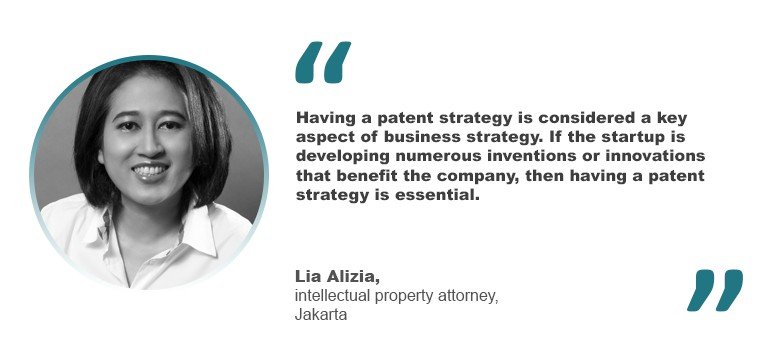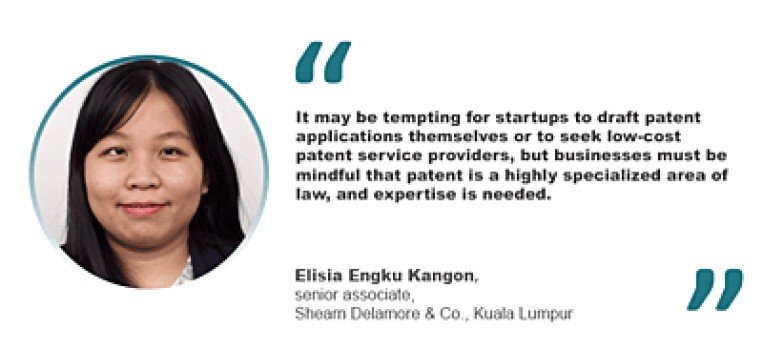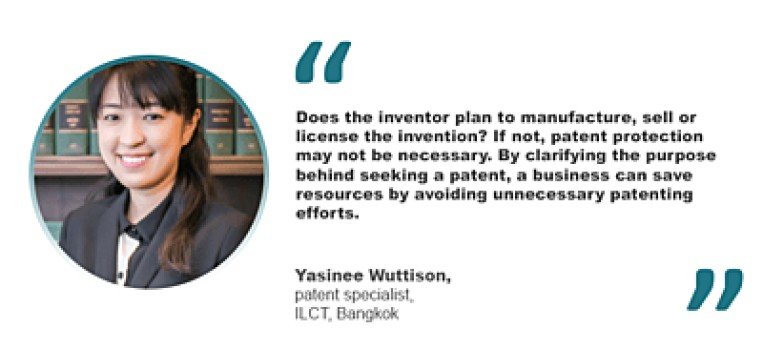For startups and SMEs: The way to a cost-effective patent strategy
31 October 2024

A patent strategy is crucial for startups and small businesses. While there are challenges such as budget constraints, Espie Angelica A. de Leon highlights the competitive advantages, potential for generating revenue through licensing and effective strategies for managing patent costs.
-
A patent strategy is a company’s comprehensive plan for acquiring, using, protecting, enforcing and maintaining its patent assets and rights covering inventions, technologies and innovations. For a patent strategy to be well-structured, it should identify the company’s key business goals and outline the necessary steps to develop a valuable patent portfolio that aligns with these goals. It should also include a plan for patent commercialization, such as licensing initiatives, among other strategies.
However, having a patent strategy comes with challenges. Foremost of these are the costs involved. In certain jurisdictions, patent prosecution and maintenance are quite expensive because these require translation of the patent specification to the local language. Also, the patent process may be lengthy in some jurisdictions, taking several years, even more than a decade, before the patent is granted, if it ever is. To begin with, patent issuance is never guaranteed, and even if a patent is granted, there is no assurance of commercial success.
Given these challenges, should a startup firm, small- and medium-sized enterprise (SME) or any company with limited resources develop a patent strategy?
“Yes, it is highly recommended for startups and small businesses to have a patent strategy, more so for startups and small businesses with tight budgets,” answered Sneha Gandhi, a partner at Obhan & Associates in New Delhi.

“While on one hand it provides a competitive edge in the market and opens avenues for the generation of investments and revenue through licensing and partnerships, thus providing financial success, on the other hand, it mitigates the risk of infringing the competitor’s patents and prevents heavy litigation expenses.”
It will also bar the market entry of competitors, giving the business enterprise more time to grow.

“Having a patent strategy is considered a key aspect of business strategy. If the startup is developing numerous inventions or innovations that benefit the company, then having a patent strategy is essential,” agreed Lia Alizia, a long-time Jakarta-based IP lawyer.
“I think the first factor to consider is which industry the startup or business operates in,” said Elisia Engku Kangon, senior associate at Shearn Delamore & Co. in Kuala Lumpur. “If the industry is innovation-oriented such as the tech industry or life sciences, then there are good reasons to have a patent strategy despite a tight budget.”
According to Kangon, patent grants are especially important to enterprises with tight budgets, including startups and SMEs since they need to create a “niche” market to distinguish themselves from their more established counterparts. Patent rights grant exclusivity, providing a company with an edge in the market.
A patent strategy also comes in handy when a small startup or enterprise wants to apply for funding.

“For example, Malaysia has launched an IP Filing Fund 2.0, which covers costs for official fees of the Malaysian Intellectual Property Office and patent agents’ fees for prior art search and patent drafting. Having a patent strategy would allow small businesses to understand their priority in terms of patent filing and assist them to plan ahead before leveraging on funding scheme,” Kangon said.
Developing a patent strategy: Steps and tips for businesses with tight budgets
“The advice and strategy will depend on the business in question. For example, the strategy for an AI company will be different from a company offering services,” noted Eugene Yang, a patent attorney at Amica Law in Singapore.
For cost-effective measures and tips, our interviewees recommend the following:
-
Consider patent strategy right at the stage of product development or from the commencement of business. According to Gandhi, this will give investors confidence, thus enhancing the likelihood of securing funding for startup ventures.
-
Choose carefully the right type of patent you want to be protected. Is it patents, designs and/or petty patents?
-
Determine which types of inventions are worth protecting. Know whether the invention behind a product can be easily reverse-engineered. “If it can, then patent protection will be important to prevent competitors from easily copying the invention. If it cannot be easily reversed-engineered, then the invention may be better protected as a trade secret,” said Yang.
-
Undertake patentability or prior art search to ensure the invention meets requirements on novelty, inventive step and industrial applicability. Do this before incurring expenses involved in securing patent rights.
-
Perform due diligence searches such as “Freedom to Operate search” before launching new products. This will help identify potential infringement threats and help prevent expensive IP infringement suits.
-
Assess the importance and potential value of inventions you intend to patent. “Key considerations include why the invention should obtain legal protection, whether it results from a unique process, or if it is expected to have future value,” said Alizia.

“For example, does the inventor plan to manufacture, sell or license the invention? If not, patent protection may not be necessary,” explained Yasinee Wuttison, a patent specialist at ILCT in Bangkok. “By clarifying the purpose behind seeking a patent, a business can save resources by avoiding unnecessary patenting efforts.” Wuttison says that Thailand is seeing rapid growth in the number of startups and small enterprises.
To determine the invention’s potential commercial viability, perform a thorough market analysis and competitive landscape assessment. “The business should have a full understanding supported by data on the significance of the invention in question,” said Kangon. “However, businesses must not just look at short-term gains but should also consider long-term benefits.”
-
Implement a targeted strategy. “Such a portfolio would need one or both defensive patents and offensive patents, in accordance with the business goals and the risks and opportunities the solution provided by the company presents,” said Gandhi.
According to Gandhi, defensive patents serve as a shield to stop others from obtaining a patent on the same subject matter. On the other hand, offensive patents act as a sword against others, serving multiple objectives, such as keeping competitors off the market, generating revenue, demonstrating company innovation and serving marketing purposes. Such a targeted patent strategy will prove to be effective and at the same time cost-efficient.
-
When filing patent applications, plan the disclosure and claims meticulously. “The patent disclosures could be such that the businesses are able to file further applications – divisional applications – on the basis of a given patent application for a certain product, apparatus or process at a later stage. This strategy will not only delay the costs of seeking IP protection but will also be effective if the applicant is unsure of the commercial viability of certain innovations,” explained Gandhi.
As for claims, tailor them to be as broad as necessary to cover innovation, but make sure the claims are specific enough to reduce or minimize costs for patent prosecution and litigation.
-
When deciding when to file a patent application, consider these factors: the stage of development, market readiness and the risk of competitors entering the market. “Ideally, legal protection for patents should be sought as early as possible to secure rights and prevent others from claiming similar inventions,” said Wuttison.
-
Be selective about which countries you would patent your invention in. “The costs of obtaining a patent and the value of the patent are not directly correlated,” revealed Yang. Furthermore, acquiring patent protection can be expensive if you are filing in multiple countries.
“Prioritize patent filings based on factors such as manufacturing locations, major competitors, key markets and export opportunities. Filing in countries where competitors are based or where manufacturing is cost-effective can help protect investments and provide strategic advantages,” said Wuttison.
According to Kangon, data collection and analysis once again come into play when determining key markets, especially if you are contemplating global patent protection.
When you’ve identified the countries where you intend to file a patent application, understand the patent systems in those jurisdictions.
-
Take advantage of accelerated patent examination programs. “Most patent offices offer a way to accelerate patent examination, and this can be a cost-effective way for an applicant with a tight budget to get a better idea of the patentability of their invention in one patent office,” noted Yang. “The positive examination result can subsequently be used to accelerate examination in other countries.”
-
As the cost of obtaining a patent is often spread over several years, do not be afraid to abandon an application if there is insufficient budget later or if the commercial interests of the company change. Therefore, consider a routine review of your patent portfolio to identify patents which have lost value.
-
Take advantage of fee rebates provided by various patent offices to small businesses.
-
Monitor industry trends continuously. By doing this, you will discover new opportunities for licensing and strategic partnerships.
-
Seek the services of an intellectual property or patent professional.

“IP and patents cover an intersection of the commercial, technical and legal aspects of a product or service. Hence, it is important to seek professional advice from an IP or patent professional who understands all three aspects and can advise the business,” said Yang.
Plus, tapping the services of an IP professional or patent agent may be more financially practical in the long run. Kangon explained: “It may be tempting for startups to draft patent applications themselves or to seek low-cost patent service providers, but businesses must be mindful that patent is a highly specialized area of law, and expertise is needed to ensure that the patent is well-drafted both in terms of technical requirements and legal rules.” This will help avoid unnecessary objections during the prosecution process.
“The worst case scenario would be expending a huge amount of money to obtain a patent grant,” Kangon added, “but it ends up worthless due to subpar patent drafting.”
Having limited financial means shouldn’t stop small enterprises from crafting their own patent strategies. However, Kangon advised startups and small businesses to be disciplined and avoid being too ambitious when doing so.






